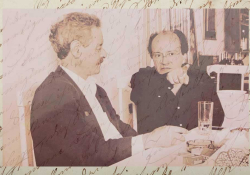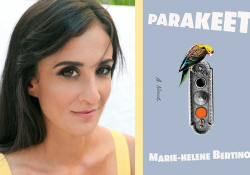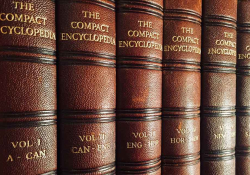Icaruses
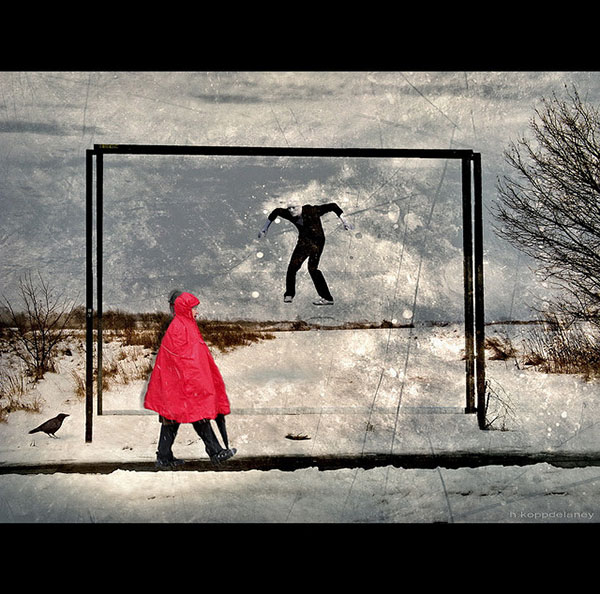
Old photographs and their conventions are both familiar and foreign to us, with their alienated and uncanny appeal. They also often seem very formal and stiff compared to the images of today, although it must be said that many of the pictures we take continue to fall into specific genres (the group shot, the goofy V-sign common in Asia, the mirrored-selfie). Perhaps most importantly, today’s digital images lack the physicality of photographs of the past. In this sense, modern photography can be seen as a form of Aristotelian mimesis highly facilitated by technology, and the more often an image is reproduced, the more the “aura” of its original suffers. Indeed, for an image that is ultimately only bytes of information, one might wonder whether an original version can even be said to exist.
Of course, image-obsessed cultures existed even before the advent of photography, when the predominant manifestations of visual mimesis were paintings and sculptures. These two art forms have particularly engaged writers’ imaginations, often leading or prompting them to respond to works of visual art in response poems, which then become new artworks in and of themselves. Such poems also offer critical readings and discussions of the original works. They shed light on our understanding of the original artworks and even on the objects or stories being portrayed, although this occurs from several removes. First, there is the real-life object itself, even if in the painting or sculpture this exists only as an imitation of an ideal version of the object; then there is the painting or the sculpture, a new object in itself, which is at a second remove; and finally, the poem is a third remove (and if we are reading a work in translation, that would be a fourth remove). This poetics of ekphrasis, that is, the reproduction of one art form through the medium of another art form, such as a painting or a photograph or a poem of a sculpture, or, perhaps more commonly, a poem about a painting, is prevalent throughout the history of art and literature. Writers from Homer to more contemporary poets such as John Ashbery have employed the poetics of ekphrasis, their techniques reflecting the unique historical and social-cultural environments in which they wrote.
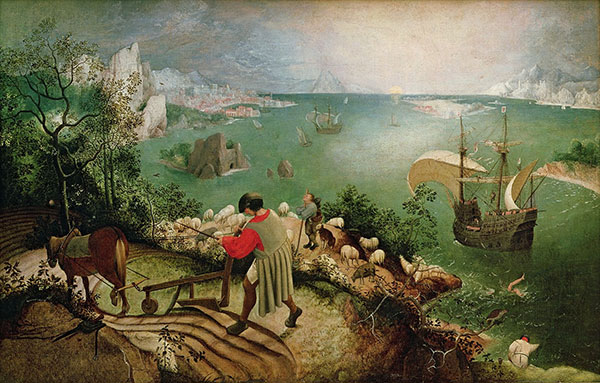
One of the most well-known examples of an ekphrastic poem is “Musée des Beaux Arts,” by the Anglo-American poet W. H. Auden. Its title refers to the Museum of Fine Arts in Brussels, which Auden visited in 1938. The poem is inspired by a painting on a mythological theme he encountered at the gallery, Landscape with the Fall of Icarus, by the Flemish Renaissance painter and printmaker Pieter Bruegel the Elder. The painting portrays, as the title suggests, the fall of the Greek mythological figure Icarus. According to the myth, Icarus and his father, Daedalus, also known as the inventor of the labyrinth, were imprisoned. To escape, Daedalus created two pairs of wings by gluing feathers to a wooden frame with wax. He gave one pair to his son, warning Icarus not to fly too close to the sun, as its heat would melt the wax that kept the wings intact. Icarus, however, elated by the ability to fly, forgot his father’s warning and flew too near the sun. The wax melted, the feathers were loosened, and Icarus plunged to his death in the sea.
Some people have argued that Bruegel’s painting is more humorous than tragic in intention and tone, as Icarus’s legs comically stick out of the water in it, suggesting mockery rather than sympathetic lament.
Bruegel’s painting portrays the moment of Icarus’s tragic fall in spring time, “a splash off the coast,” as William Carlos Williams has it, but the inanimate objects in the painting—the trees, the ships, the rocks—are indifferent and incapable of empathy. Worse, most of the human figures and animals turn away and do not seem to be aware of Icarus’s tragic fate. The vast, glorious sea becomes the primeval womb that swallows Icarus, and everybody seems to be complicit in his death, as his final attempts to stay afloat prove futile. One might be reminded of the poem by the English poet Stevie Smith titled “Not Waving But Drowning.” Although the poem is not a direct reference to the myth of Icarus or Bruegel’s painting, it similarly portrays a drowning man whose audience is oblivious to his fate. In the poem, the man’s call for help is unfortunately not heard, and his gestures of distress are mistaken as lighthearted waving. Because the man “always loved larking,” in this crucial moment, he is not taken seriously. The bystanders are oblivious to the drowning man’s plight, just as the human figures in Bruegel’s painting fail to or refuse to pay attention to Icarus’s struggle for life. Some people have argued, however, that Bruegel’s painting is more humorous than tragic in intention and tone, as Icarus’s legs comically stick out of the water in it, suggesting mockery rather than sympathetic lament. It is as though Icarus is merely waving clownishly with his limbs rather than showing signs of drowning.
Whether Bruegel’s portrayal of Icarus’s fall is supposed to be read as tragic or comic is left to the viewer to decide, and it is this ambiguity that makes the work interesting and perhaps even adds to its enduring appeal.
Whether Bruegel’s portrayal of Icarus’s fall is supposed to be read as tragic or comic is left to the viewer to decide, and it is this ambiguity that makes the work interesting and perhaps even adds to its enduring appeal. However, in Auden’s poem “Musée des Beaux Arts,” the scene in the painting is given a definite interpretation, an interpretation that is heavier and more serious. Indeed, the scene is used to consolidate Auden’s condemnation of humanity’s uncaring attitude toward the suffering of others. The first stanza, for example, describes scenes of “suffering,” “while someone else is eating or opening a window or just walking dully along”; that is, while someone else is doing the most mundane and mindless of daily activities. Auden’s poem is thus first and foremost a reflection on the human condition and on our indifference, or as the Chinese saying has it, “One only sweeps the snow immediately in front of one’s front door.” But Auden’s poem is also a part-commentary on and part-narration of Bruegel’s painting, which Auden uses to support his argument. The rather vague “suffering” in the first stanza is concretized in the second stanza with the example of Icarus, whose suffering sparks no stirrings in the ploughman or the people in the “delicate ship.” Everybody remains calm and splendidly unmoved while a boy has just fallen out of the sky and is about to die.
The American poet Anne Sexton presents a very different take on the Icarus story in her poem “To a Friend Whose Work Has Come to Triumph” (not to be mistaken with Yeats’s similarly titled poem). Although she does not name Bruegel’s painting explicitly, Sexton is likely to know of the painting and/or its description in Auden’s poem. Indeed, she offers descriptions that gesture toward certain images in Bruegel’s work: “There below are the trees, as awkward as camels” and “here are the shocked starlings pumping past.” Sexton’s poem, however, instead of merely narrating the static scene recalled in the painting, also imagines what takes place before the fall, such as the wondrous moment when Icarus first feels the elation of flying or his pride while looking directly at the sun, almost claiming it as his own, even as his neck is burning. In Sexton’s poem, Icarus’s fall is not shameful or pitiable. Instead, Icarus is triumphant, defiant, and without regrets, even though his actions destine him to his own death.
Whereas both Auden’s and Sexton’s poems are clear homages to Bruegel’s painting, a poet can also respond to an artwork more indirectly. My next example is “To the State Electrical Worker,” a poem by the contemporary American poet Robert Masterson, published three years ago. In it, Masterson transforms the story and the setting of Bruegel’s painting to a different location, a different time, and a different social, cultural, and political context.
To the State Electrical Worker
Robert Masterson
. . . killed while working on a giant steel pylon supporting the massive power lines spanning the Wei He River north of Xi’an, Shaanxi Province, the People’s Republic of China, in the fall of 1985
I still now as I did then wonder
what it must have looked like to you incandescent,
eyeballs ribboned with blue fire
and below you spreading all horizon,
the city slowly pulsed, hot and dusty for this late in the year,
everyone says so.
Who knows, who will ever know what caused your fatal spark,
the brilliant arc that clenched you tight, convulsed in one long spasm when
everything inside you jammed up with electricity rampant and when
you began to smolder, I wondered then as I still do now
if you even noticed you were on fire.
The river bridge was jammed both ways,
typical post-revolutionary rush hour
and a quarter of a million people stopped their bicycles
and put one leg on the pavement so they could safely stare up goggle-eyed
and open-mouthed at something different,
at a man two hundred feet in the air who twitched
and blackened and was never coming down.
The wrongness of this all is huge,
and still now as then I consider what it must seem
to you there among the wires thrumming harsh, the river silver
and thin along the wide sandy bottom,
just diesel smoke from idle engines like mist in a scroll painting
one thousand years old, this same river and this same city,
now hanging in a temple in
the mountains far to the west.
(First published in the November 2011 issue of Cha: An Asian Literary Journal. Reprinted here with the author’s permission.)
Masterson’s “To the State Electrical Worker” is an evocative and powerful exploration of tragedy and our callous response to it. The poem recalls Auden’s “Musée des Beaux Arts,” but while Auden’s work is about how people can be oblivious to events and suffering around them, Masterson’s poem shows how the plight of others is often treated as little more than public spectacle.
While Auden’s work is about how people can be oblivious to events and suffering around them, Masterson’s poem shows how the plight of others is often treated as little more than public spectacle.
As the title of Masterson’s poem makes clear, the piece is dedicated to a particular but unnamed Chinese electrical worker, who is the contemporary Icarus, so to speak. The title flows into the prologue, and it is here that we learn about the worker’s shocking death. Written in a factual style, the introduction informs us that the man was “killed while working on a giant steel pylon supporting the massive power lines spanning the Wei He River.” Already, in this statement, we see the themes of the poem emerging. At first glance, the event described, while both dramatic and tragic, would seem to be a relatively minor one in the history of China. Indeed, the use of phrases such as “giant steel pylon” and “massive power lines” effectively signal the insignificance of the individual when compared to the nation’s industrial might.
Yet despite the modest background of the man, his electrocution has captured the attention of the poet and his persona. It is unclear whether the speaker in the poem was present at the scene or is simply re-creating an event he has read about. He nevertheless continues to obsess over the accident, the line “I still now as I did then wonder” (and its variations) suggesting a temporal distance between the worker’s death and the writing of the poem. After the intervening time, he is still unable to come to a conclusion about what triggered the event and muses, “Who knows, who will ever know what caused your fatal spark.”
The speaker imagines “the brilliant arc that clenched you tight, convulsed in one long spasm when / everything inside you jammed up with electricity rampant and when / you began to smolder.” Here, the poet starkly captures the physicality of the event, and it is easy to picture the worker’s suffering. The speaker also wonders about the man’s mental state, asking whether “you even noticed you were on fire,” an image that recalls Anne Sexton’s Icarus, whose neck feels the fire. Whether or not the worker is fully aware of his situation, the speaker does present him as a kind of reverse witness to his own death, asking what it must have looked like while “you incandescent, / eyeballs ribboned with blue fire,” watched as the city “pulsed, hot and dusty” below.
The city also looks up to watch the man. The river bridge below was “jammed both ways” in a “typical post-revolutionary rush hour,” but the dying worker still proves enough of a spectacle for “a quarter of a million people” to stop their bicycles and “put one leg on the pavement so they could safely stare up goggle-eyed / and open-mouthed.” In this description, the poet provides a sense that the crowd is formed of jaded and unfeeling bystanders who find diversion in a stranger’s misfortune. This impulse has recently produced rather questionable images such as a man who was pushed by a homeless man in front of a train in a New York subway and one person’s reaction was to take a photograph instead of helping. In Masterson’s poem, it is perhaps easy to overemphasize the cynicism of the crowd as there is little that any one individual can do to rescue the man. Is it worse to ignore a dying man you cannot help or watch his demise? In the use of phrases such as “goggle-eyed” and “open-mouthed,” which are intended to convey the onlookers’ rapt attention, the poet, whether consciously or not, also has the crowd empathetically mirror the worker’s own physical state, his “eyeballs ribboned with blue fire” and his twisting convulsions.
Still, for the commuters, the sight of a man “two hundred feet in the air who twitched” and “was never coming down” is little more than “something different” to be experienced, a living (or maybe dying) piece of art. This takes us back to Auden’s “Musée des Beaux Arts.” In Auden’s take on Bruegel’s painting, everyone and “everything turns away / Quite leisurely from the disaster” of Icarus’s falling from the sky. In Masterson’s poem, however, everyone watches the disaster quite leisurely, and unlike in “Musée,” in which we are not privy to Icarus’s final thoughts, here we see the poet at least try to imagine the victim’s experience.
The final stanza begins with a moral judgment: “The wrongness of this all is huge.” Presumably the speaker is referring to the indifference of the crowd toward the electrical worker or perhaps the indifference of Chinese society generally toward individuals. But are the speaker and poet in “To the State Electrical Worker” also speaking about their own guilt in exploiting the event? Although they are sympathetic recorders of the accident, they too are in some sense using the worker’s death. This is perhaps somewhat overstated, as there is an honest attempt in the poem to capture the electrical worker’s final moments, moments that may have otherwise been lost to history.
As the stanza progresses, the speaker wonders “what it must seem / to you there among the wires thrumming harsh,” as “the river silver / and thin” passed below. From this image, the speaker pulls out to imagine the worker’s place in the vast history of the Wei He River and China, saying that the view is reminiscent of a scroll painting of the same location a thousand years ago, “now hanging in a temple,” except that the ancient mists have been replaced by “diesel smoke from idle engines.” In this final aestheticization of the event, Masterson offers an allusion to Auden’s poem and reminds us of the work’s complicated ekphrastic relationships—to the Icarus story via Bruegel, via Auden, reworked in a Chinese context, and to thousands of years of Chinese history seen through a scroll painting. Perhaps the poet is suggesting that “To the State Electrical Worker” is an attempt to capture the man’s life in art? Or is he suggesting that this particular tragedy is insignificant when compared to the history of the city and river? Or is it something else? The poem leaves it up to the reader to decide.
Hong Kong Baptist University

